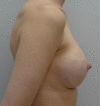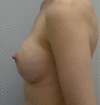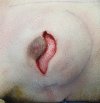Implant-based breast reconstruction following conservative mastectomy: one-stage vs. two-stage approach
- PMID: 26855908
- PMCID: PMC4716858
- DOI: 10.3978/j.issn.2227-684X.2015.06.08
Implant-based breast reconstruction following conservative mastectomy: one-stage vs. two-stage approach
Abstract
Conservative mastectomy with preservation of the nipple areolar complex is now considered a safe and effective technique in properly selected patients. Good candidates for this procedure include women with small to moderate breast volume having therapeutic or prophylactic mastectomy. Both autologous and prosthetic options are available; however prosthetic techniques are performed more frequently. Prosthetic approaches include immediate 1-stage (direct to implant) or 2-atge (tissue expander/implant) techniques. Delayed prosthetic reconstruction is also possible with conservative mastectomy. This manuscript will review the 1-stage and 2-stage methods with an emphasis on indication, surgical techniques, and outcomes.
Keywords: Breast reconstruction; breast implants; conservative mastectomy; nipple sparing mastectomy; tissue expanders.
Conflict of interest statement
Figures














Similar articles
-
Nipple-areolar complex ischemia after nipple-sparing mastectomy with immediate implant-based reconstruction: risk factors and the success of conservative treatment.Aesthet Surg J. 2014 May 1;34(4):560-70. doi: 10.1177/1090820X14528352. Epub 2014 Mar 28. Aesthet Surg J. 2014. PMID: 24682442
-
Comparison of Reconstructive Outcomes in Breast Cancer Patients With Preexisting Subpectoral Implants: Implant-Sparing Mastectomy With Delayed Implant Exchange Versus Immediate Tissue Expander Reconstruction.Ann Plast Surg. 2016 Jun;76 Suppl 4:S332-5. doi: 10.1097/SAP.0000000000000751. Ann Plast Surg. 2016. PMID: 27187252
-
Bilateral prophylactic mastectomy in BRCA mutation carriers: what surgeons need to know.Ann Ital Chir. 2019;90:1-2. Ann Ital Chir. 2019. PMID: 30872561
-
Breast reconstructive techniques in cancer patients: which ones, when to apply, which immediate and long term risks?Crit Rev Oncol Hematol. 2001 Jun;38(3):231-9. doi: 10.1016/s1040-8428(00)00137-2. Crit Rev Oncol Hematol. 2001. PMID: 11369256 Review.
-
Oncologic safety of conservative mastectomy in the therapeutic setting.Gland Surg. 2016 Feb;5(1):37-46. doi: 10.3978/j.issn.2227-684X.2015.05.13. Gland Surg. 2016. PMID: 26855907 Free PMC article. Review.
Cited by
-
Relevant In Vitro Predictors of Human Acellular Dermal Matrix-Associated Inflammation and Capsule Formation in a Nonhuman Primate Subcutaneous Tissue Expander Model.Eplasty. 2017 Jan 5;17:e1. eCollection 2017. Eplasty. 2017. PMID: 28119764 Free PMC article.
-
Transaxillary Single-Port Endoscopic Nipple-Sparing Mastectomy with Immediate Implant-based Breast Reconstruction in Breast Cancer Patients Receiving Neoadjuvant Chemotherapy or Not: A Comparative Study with Analysis of Surgical Complications and Patient-Reported Outcomes.Aesthetic Plast Surg. 2023 Dec;47(6):2304-2321. doi: 10.1007/s00266-023-03644-0. Epub 2023 Sep 12. Aesthetic Plast Surg. 2023. PMID: 37700196
-
Direct-to-Implant Extracellular Matrix Hammock-based Breast Reconstruction; Prepectoral or Subpectoral?Trials. 2020 Feb 10;21(1):160. doi: 10.1186/s13063-020-4125-6. Trials. 2020. PMID: 32041661 Free PMC article.
-
Factors Associated with Reconstruction Failure and Major Complications After Postmastectomy Radiation to a Reconstructed Breast.Pract Radiat Oncol. 2023 Mar-Apr;13(2):122-131. doi: 10.1016/j.prro.2022.09.005. Epub 2022 Nov 1. Pract Radiat Oncol. 2023. PMID: 36332800 Free PMC article.
-
Effect of Radiotherapy on the Type and Timing of Breast Reconstruction After Mastectomy in Breast Cancer Patients.Sisli Etfal Hastan Tip Bul. 2024 Dec 24;58(4):401-410. doi: 10.14744/SEMB.2024.34033. eCollection 2024. Sisli Etfal Hastan Tip Bul. 2024. PMID: 39816433 Free PMC article. Review.
References
-
- Spear SL, Willey SC, Feldman ED, et al. Nipple-sparing mastectomy for prophylactic and therapeutic indications. Plast Reconstr Surg 2011;128:1005-14. - PubMed
-
- Endara M, Chen D, Verma K, et al. Breast reconstruction following nipple-sparing mastectomy: a systematic review of the literature with pooled analysis. Plast Reconstr Surg 2013;132:1043-54. - PubMed
-
- Albornoz CR, Bach PB, Mehrara BJ, et al. A paradigm shift in U.S. Breast reconstruction: increasing implant rates. Plast Reconstr Surg 2013;131:15-23. - PubMed
-
- Cemal Y, Albornoz CR, Disa JJ, et al. A paradigm shift in U.S. breast reconstruction: Part 2. The influence of changing mastectomy patterns on reconstructive rate and method. Plast Reconstr Surg 2013;131:320e-6e. - PubMed
-
- Salzberg CA, Ashikari AY, Koch RM, et al. An 8-year experience of direct-to-implant immediate breast reconstruction using human acellular dermal matrix (AlloDerm). Plast Reconstr Surg 2011;127:514-24. - PubMed
Publication types
LinkOut - more resources
Full Text Sources
